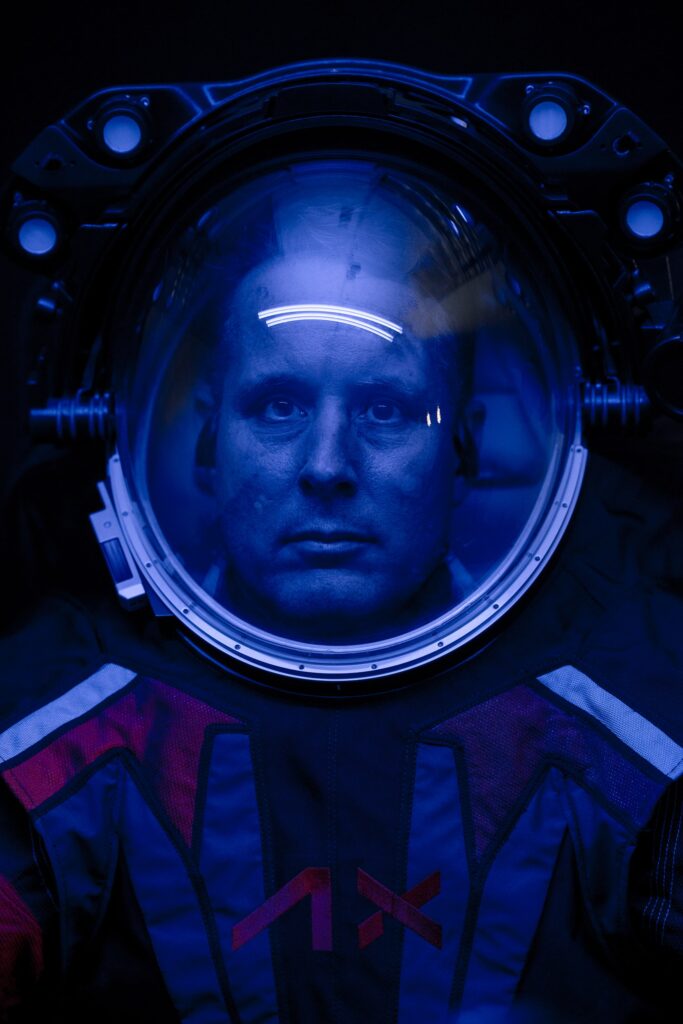The first-ever spacesuits, designed in the late 1950s for the United States’ inaugural man-in-space mission, were shiny silver. By the end of the next decade, they were puffy-white and paired with boots for walking on the Moon. The 1980s saw the arrival of the bright orange “leisure” space suit made for inside the spacecraft. This decade, as branding-minded billionaires have begun traveling to the outer limits of the atmosphere, functional space fashion has diversified, with Elon Musk’s SpaceX, Jeff Bezos’s Blue Origin, and Richard Branson’s Virgin Galactic companies all crafting suits of their own.
NASA, meanwhile, has revealed a working prototype for the newly designed spacesuits its astronauts will wear during the planned Artemis III mission, which is slated to take place in 2025—the agency’s first human-led Moon landing since the last Apollo lunar flight in 1972. And the design is sleeker than the doofy box-shaped SpaceX suits and less corny than Blue Origin’s cobalt coveralls (which Bezos wore with a freaking cowboy hat) and Virgin Galactic’s Tron-style uniforms.
The prototype, which was designed by the Houston-based aerospace company Axiom Space under contract from NASA, features an off-black fabric with blaze-orange and sky-blue detailing (the company’s brand colors) at the shoulders, knees, wrists, and ankles, plus a big ol’ orange Axiom logo printed on a V-shaped overlay at the center of the chest.
The Axiom Space AxEMU Spacesuit prototype.
Courtesy of Axiom Space
This design, however, is more of a display-only dust cover for the actual suit, which will have a white external layer in order to reflect heat from the sun. Axiom collaborated on the custom cover with costume designer Esther Marquis from the Apple TV+ science-fiction series For All Mankind, an alternate history about how space exploration might have played out if the Soviets had landed on the Moon before the Americans in 1969. (Hint: the U.S. would have leaned way into it.)
For the record, a billionaire pioneered the Hollywood route for space suit design. In 2020, Musk partnered with costume designer Jose Fernandez, who has worked on Batman v Superman and a number of Marvel movies, to design the SpaceX suits, which Musk said he wanted to emulate tuxedos.
Of course, there’s more to the new NASA suit than the involvement of a costume designer. As Nicholas de Monchaux, the head of architecture at M.I.T. and author of a book about the Apollo spacesuits, described it to Vanessa Friedman of The New York Times, the suit is “really less a piece of clothing than a very small building or a very small spacecraft.” And beyond its critical functionality, it makes a philosophical statement. It is, de Monchaux said, “the costume for the drama we project into space,” the way we “put ourselves into the heavens.”
Courtesy of Axiom Space
As for the real Artemis III lunar suits, their flexible design is meant to accommodate a broad range of crew members; it is also the first NASA spacesuit to be specifically designed to fit a woman. (As recently as 2019, one of the female astronauts whom NASA planned to send as an all-women team to the International Space Station got bumped from the mission because they didn’t have enough suits in the correct sizes to accommodate the whole crew. They ended up having to send a male colleague in her place.) According to a NASA press release, “Through Artemis, NASA will land the first woman and the first person of color on the Moon, paving the way for a long-term, sustainable lunar presence to explore more of the lunar surface than ever before and prepare for future astronaut missions to Mars.”
The boots will also feature special insulated soles made to withstand the below-freezing temperatures of the sunless lunar south pole, which is an important feature for this particular mission: it’ll be the first time that astronauts will venture to a permanently shaded region on the Moon.
NASA had been trying for 15 years to develop its own next-generation moon suit before outsourcing the project to Axiom last summer. (Apparently, per the NASA release, this contracting process is referred to as purchasing “moonwalking services.”) The federal agency last shared its own plans in 2021, when Musk was quick to criticize their plan to hire 27 external vendors to supply various technical parts of the suits’ design. “Seems like too many cooks in the kitchen,” he replied to a screenshot of the proposed diagram on Twitter, adding that “SpaceX could do it if need be.”
